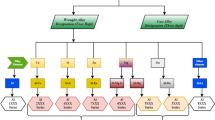Abstract
During its history, aluminum’s attractive features, such as high strength-to-weight ratio, good electrical mass conductivity, and unique corrosion behavior, have led to a spectacular expansion in its use. The role of aluminum in non-aluminum-based materials is also very important; its contribution to the improvement of magnesium and titanium alloys and to highly complex packaging materials are some of the noteworthy examples. Significant cost reductions on the basic metal production level, near-to-shape fabricating methods, and the well-functioning recycling system are also major contributors to aluminum success. Imminent challenges for the industry are the need for products with very close tolerances on a mass fabricating repetitive basis and just-in-time delivery to original-equipment manufacturers and small users through distributors. A significant part of the challenges remains in the applications area, particularly automotive and aerospace.
Similar content being viewed by others
References
S.R. Johnston, “Aluminium,” Mining J (January 22, 1999).
H.A. Øye et al., “Aluminum: Approaching the New Millennium,” JOM, 51 (2) (1999), pp. 29–42.
Aluminum Association Inc. Industry Facts (Washington, D.C.: Aluminum Association, 1994).
J.E. Hatch et al., Aluminum Properties and Physical Metallurgy (Metals Park, OH: American Society for Metals, 1984), p. 231.
A. Wringley, “Automakers Seek Favorable Material Balance,” American Metal Market (March 23, 1999).
G. Binczewski, “Recycling of Metals and Engineered Materials,” Light Metal Age (February 1996), pp. 40–44.
E. Nussbaum, “Aluminum Scrap Recycling Plant at AMAG, Ranshofen, Austria,” Light Metal Age (April 1998), pp. 52–60.
O. Manfredi et al., “Characterizing the Physical and Chemical Properties of Aluminum Dross,” JOM, 49 (11) (1997), pp. 48–51.
R.N. Szente et al., “Recovering Aluminum via Plasma Processing,” JOM, 49 (11) (1997), pp. 52–55.
M. Pinkham, “Aluminum Makes Inroads in Automotive Market,” American Metal Market (March 23, 1999).
A. Wringley, “Auto Industry Eyes Lighter Liners,” American Metal Market (November 16, 1998).
A. Wringley, “Lighter Materials Revving Up,” American Metal Market (April 5, 1999).
H.N. Han, “The Environmental Impact of Steel and Aluminum Body-in-Whites,” JOM, 48 (2) (1996), pp. 33–35.
A. Wringley, “Alliance Bodes Well for Aluminum,” American Metal Market (June 15, 1999).
G. Binczewski, “Aluminum Casting Solutions for the Millennium,” Light Metal Age (December 1998), pp. 38–41.
J.-P. Gabathuler et al., “Thixocasting: A New Process for the Production of High-Quality Parts” (Paper presented at the E-MRS Spring Meeting, Symposium on Advances in Solidification Processes, Strasbourgh, France, 4–7 May 1993).
A.J. Bryant et al., “Developments in Billet and Extrusion Metallurgy on the Operation of the Extrusion Process,” Light Metal Age (April 1998), pp. 6–34.
P. Robbins, “Cooperation—Key to Profit in Extruding Aluminum,” Light Metal Age (April 1998), pp. 40–43.
P. Robbins, “Who are Superextruders?” Light Metal Age (April 1997), pp. 67–74.
Junker Catalogues, nos. 3307, 3346 and 3376.
V.L. Berezhnoy, “Friction Assisted Extrusion, as an Alternative to the Indirect and Direct Extrusion of Hard Aluminum Alloys,” Light Metal Age (April 1997), pp. 8–13.
“AECS’ 1995 International Extrusion Technology Exchange Tour,” Light Metal Age (August 1995), pp. 22–28.
J. Csak et al., Cold Extrusion of Solid Aluminum Profile Bars (in Hungarian) (Kohaszati Lapok, 1995), pp. 164–169.
A.I. Nussbaum, “Continuous Aluminum Extrusion by the Conform Process,” Light Metal Age (August 1995), p. 68.
A.L Nussbaum, “Rebirth of the Castex Process,” Light Metal Age (April 1994), pp. 36–38.
B. Werner, “Creativity and Technology with Extrusions,” Light Metal Age (October 1995), pp. 30–33.
“New Bend Shaping Technique for Aluminum Space Frame Components,” Light Metal Age (June 1994), p. 42.
J.C. Benedyk, “Retrogression Heat Treatment Applied to Aluminum Extrusions for Difficult Forming Applications,” Light Metal Age (October 1996), pp. 8–10.
M.T. Smith et al., “Optimization of Light Metal Forming Methods for Automotive Application,” Light Metal Age (October 1997), pp. 24–28.
A.I Nussbaum, “Three State of the Art High Speed Roll Casters for Aluminum Sheet Products,” Light Metal Age (December 1998), pp. 8–19.
I.M. Marsh et al., “Development of Continuously Cast High Quality Aluminum Sheet,” Light Metal Age (August 1994), pp. 46–49.
W.F. Hosford et al., Metal Forming, Mechanics and Metallurgy (Bridgewood Cliff, NJ: Paramount Communication Co., 1993).
R.H. Wagoner et al., “Sheet Metal Forming—Automation and Improvement,” JOM, 37 (12) (1985), pp. 33–38.
S. Koss et al., “New Solution for Aluminum Car Body Sheets,” Light Metal Age (December 1997), pp. 20–26.
Protection Electrolitique des Metaux (Cheville, France: Catalogus, 1992).
Recent Developments in Aluminum Foil Packaging (Omega Research Associates, 1994).
D.L. Davidson, “The Mechanical Properties of In-Situ Composites: An Introduction and Speculation,” JOM, 49 (8) (1997), p. 34.
R.M. Aikin, Jr., “The Mechanical Properties of In-Situ Composites,” JOM, (29 (8) (1997), pp. 35–39.
Author information
Authors and Affiliations
Additional information
Author’s Note: This article, dealing with current trends in downstream activities and the challenges the aluminum fabricating industry is facing, serves as a follow-up to the article “Aluminum: Approaching the New Millennium,” by H.A. Øye et al., which appeared in the February 1999 issue of JOM.
For more information, contact M.N. Becker, SNC-Lavalin, Aluminum Division, 455 Boulevard Rene-Levesque West, Montreal, Quebec, Canada H2Z 1Z3; (514) 399-1658; fax (514) 395-1323; e-mail mxbecker@bechtel.com.
Rights and permissions
About this article
Cite this article
Becker, M.N. Aluminum: New challenges in downstream activities. JOM 51, 26–38 (1999). https://doi.org/10.1007/s11837-999-0220-6
Issue Date:
DOI: https://doi.org/10.1007/s11837-999-0220-6




